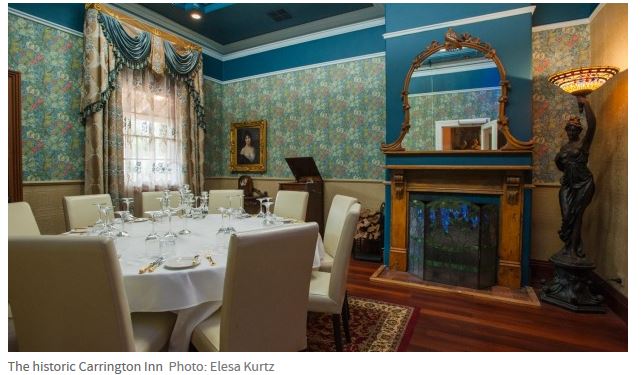Author Christine M Knight’s Blog
The Restoration of the Carrington Inn, Bungendore
Late October, I met Innkeeper, Richard Graham in the motel carpark of The Carrington Inn a few weeks after it had reopened.
Originally known as The Lord Carrington Hotel, the property was built between 1884-85. It was named after the newly appointed governor of NSW. When the governor retired, the inn became The Carrington Hotel.
In the 20th century, descendants of the Winters sold the property to Toni Dale who reverted the property to its original function from a domestic residence. It later changed hands until Richard bought it eight years ago.
As we walked through the half acre of man-made gardens’ entrance to the Wintergarden complex, I was struck by their intrinsic naturalness and the patterns of dappled light. Richard said they are ‘one of the largest publicly accessible private gardens in the region.’ He credits the illusion of a much larger space to the use of meandering sinuous paths.
There are three distinct themed locations within the Wintergarden complex: The Tom Wills Tavern, The Empire Hall and Salons – fine dining, and Myee’s Tearoom. Myee is pronounced my. The tavern’s namesake and a local, Tom Wills was a leading Australian cricketer from 1856 and is said to be the founder of Australian Rules football. Heavy drinking was apparently part of the sport’s culture at that time and purportedly played a role in his tragic death in 1880.

Maria Myee Gallagher, 1889-1967, was the granddaughter of the original owner, William Daniel Winter. ‘An educated woman of many talents, Maria Myee never married and lived in the hotel throughout her life.’ She was a skilled pianist and taught the piano as well as the sewing arts and painting to locals. She was also well-known for her charitable work in the town. The interview and tour began in Myee’s tearoom. Its décor, like the rest of the complex, ‘pays deference to the 19th century colonial Victorian nature of the Carrington Inn.’ An airy and serene space, the tearoom’s authentic hand-painted stencilled wallpaper, pale green wainscoting, slate floor, furnishings, and hanging baskets suggest a Victorian garden conservatory.
When I asked about the ideas underpinning the renovation process, Richard explained the choice before him. Restore the inn to look like the property as it had been in 1885 or restore it to reflect the Victorian era from 1885 but have modern restaurant equipment. For commercial reasons, he opted for the latter.
After much research, Richard and his team distilled the Victorian period to a single restoration intention: ‘allow modern-day patrons to appreciate the aspirational nature of the Victorian era’ and witness a different lifestyle.
The aspirational mood of the period is clearly visible in the style of ceilings in the tavern and the Empire Hall and Salons. The tavern’s patterned copper ceiling is reminiscent of Tudor ceilings and represents the revival of British styles during the Victorian era. The decorative tin ceiling in one of the salons is another popular architectural element from that period as are the subtly lit, rounded vaulted plaster ceilings in the Empire Hall.

The Victorian theme is evident in the use of decoratively etched glass mirrors, beautiful period-styled drapery, luxurious furnishings, dining settings, and décor accents. Thirty-three hand-painted artwork reproductions tell the colonial story, including artwork by Tom Roberts. In the tradition of the time, a picture of Queen Victoria dominates the Empire Hall.
The attention to authentic detail is also seen in the use of deeply embossed wall covering (Lincrusta) in the Empire Hall. Lincrusta was invented in Britain in 1877 by the same man who invented linoleum floor covering some years before.

Having visited many famous historic sites, I found The Carrington Inn as striking as places like Chatsworth House and Hampton Court in UK. Of course, The Carrington’s pristine interior décor and the inn are much smaller in scale than those other historic UK properties. As Richard told the stories behind each room’s décor, I realised that he is more than the owner and operator of an enterprise that happens to exist in a heritage property. He is keenly aware of his custodial role in restoring, documenting, and protecting heritage.
As I left that afternoon, I realised that heritage places not only add dimension to the character of a community and its diversity but to its unique features of streetscapes as well.

Left to right: Mark Summers, General Manager; Edwina Fitzgerald, Accommodation Manager; Me, Innkeeper; Merili Pihlamäe, Venues Manager; and Andrew Stansbie, Executive Chef.